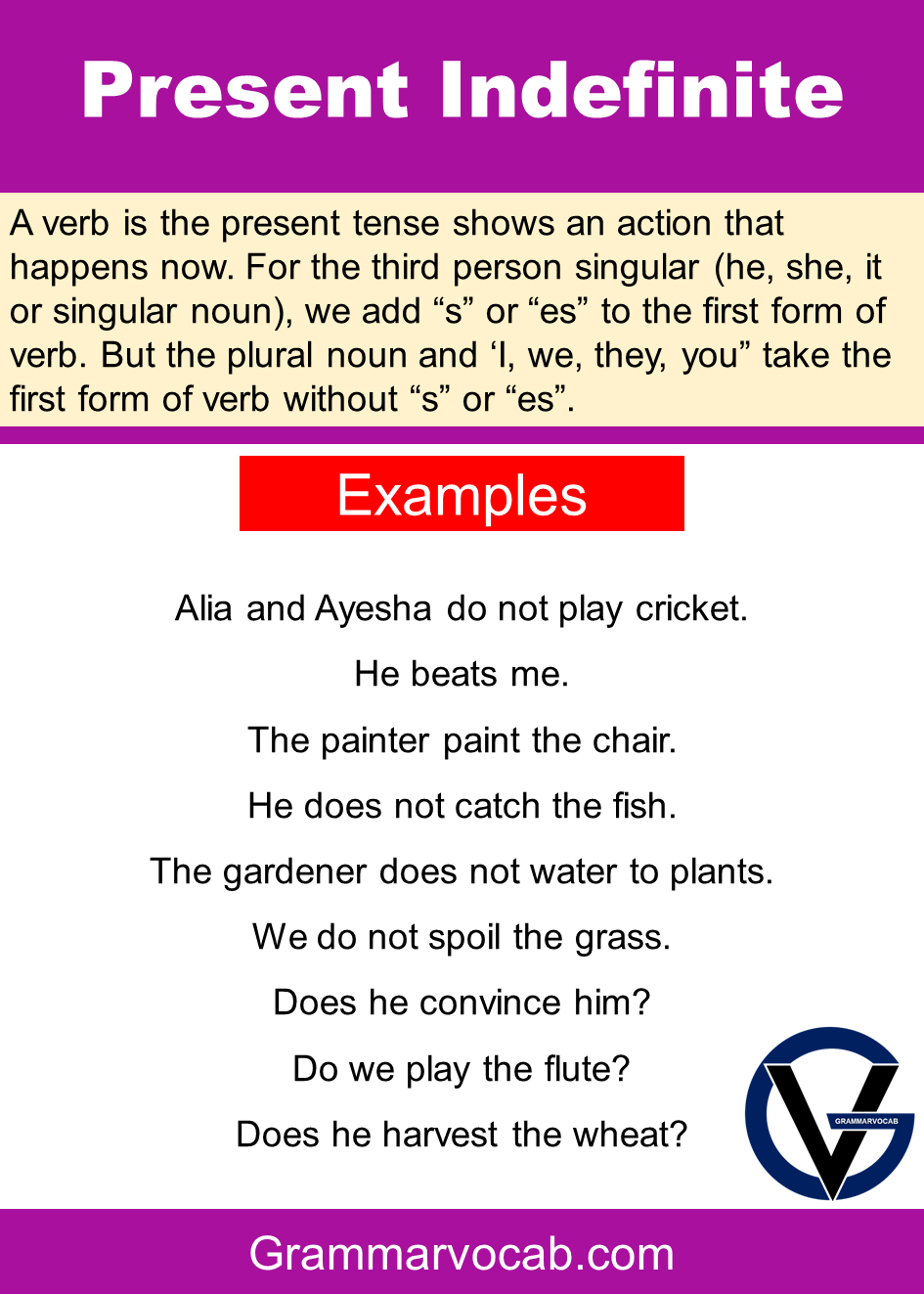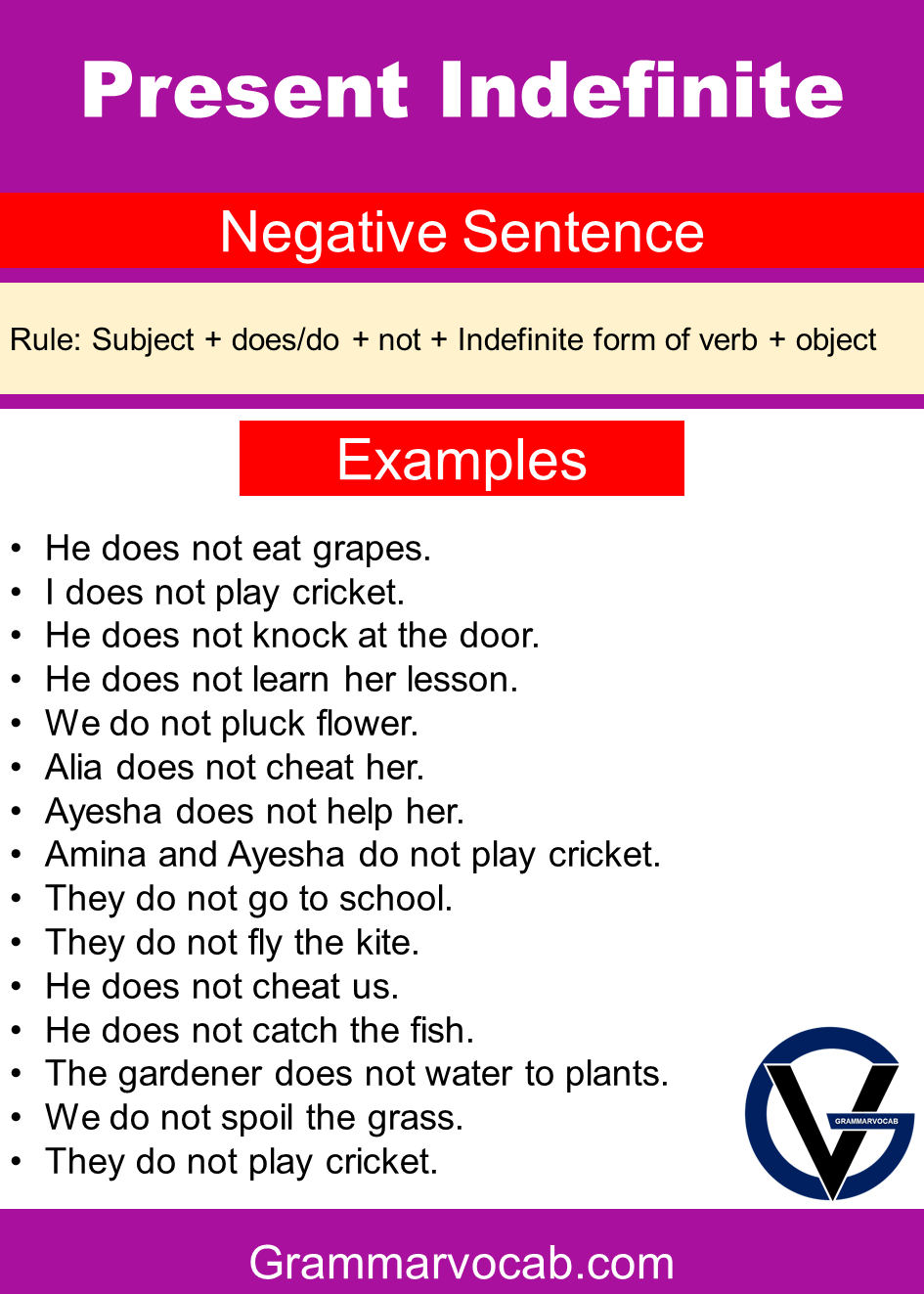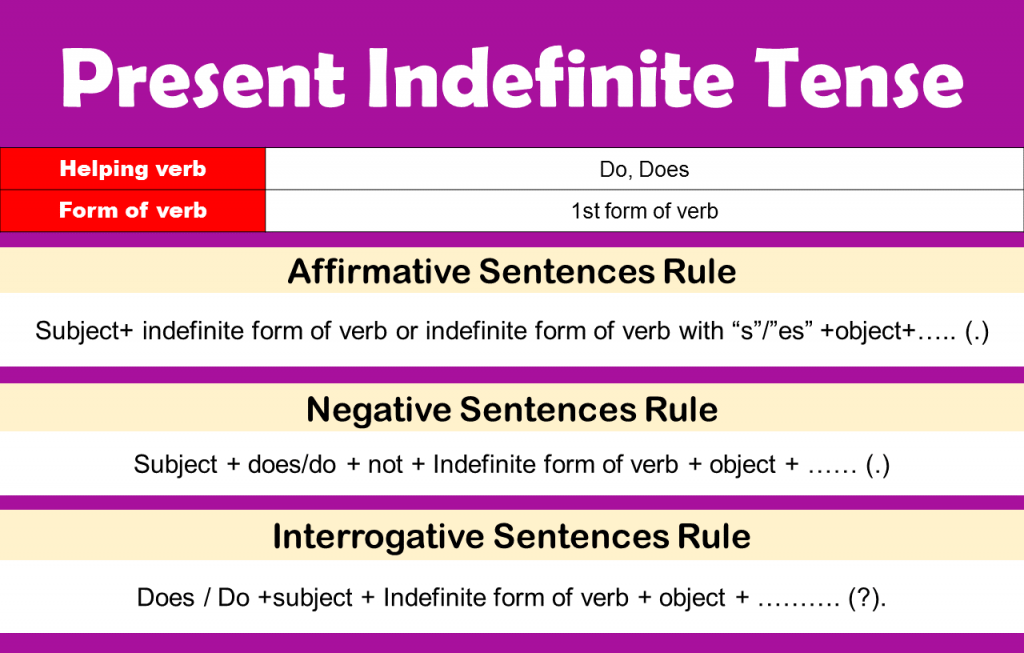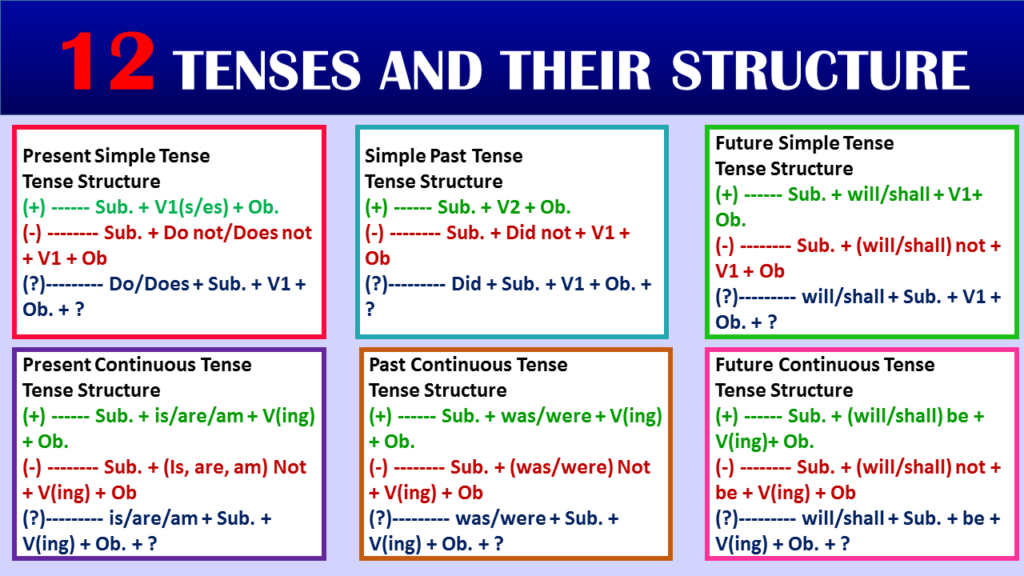The present indefinite tense, also known as the simple present tense, is used to describe actions that are happening right now, habitual actions, general truths, and scheduled future actions. This tense doesn’t require the action to be happening at the exact moment of speaking; it can refer to actions that occur regularly, such as daily routines or permanent situations.
In the present indefinite tense, verbs are usually in their base form (the simple form of the verb, e.g., “talk,” “eat,” “work”) with no changes for the subject (no -s or -es endings as in the present continuous tense). However, there are exceptions to this rule, which we will explore later in this article.

Affirmative Sentences
The Present Indefinite Affirmative Tense, also known as the Simple Present Tense, is a grammatical tense used to describe actions, events, or situations that are generally true, habitual, or regularly occurring in the present time. It is used to convey facts, routines, and timeless statements. In this tense, the action is not necessarily happening right at the moment of speaking but is considered to be a general truth or a recurring event.
Present Indefinite Affirmative Tense Rules
To effectively use the present indefinite tense in your writing and conversation, it’s essential to understand the rules governing its usage.
Rule: Subject+ indefinite form of verb or indefinite form of verb with “s”/”es” +object+….. (.)
Examples
- You waste your time.
- The sun rises in the east.
- We follow the teachings of the Holy Quran.
- He goes to school regularly.
- He goes to college.
- They go to college.
- He plays hockey.
- Rida tries.
- They play cricket.
- He likes to go to school.
- We want to go to school.
- She knows how to iron the clothes.
- Alia does not cheat her.
- Ayesha does not help her.
- Alia and Ayesha do not play cricket.
- He beats me.
- Water boils at 100 degrees Celsius.
- The Earth revolves around the Sun.
- English has many irregular verbs.
- He always arrives early for meetings.
- I usually go to the gym in the evening.
- They sometimes visit their grandparents.
- She plays the piano.
- He eats dinner at 7 PM.
- The sun rises in the east.
- She reads books every evening.
- They travel to new places frequently.
- He speaks fluent Spanish.
- I work in an office.

Negative Sentence
The Present Indefinite Negative Tense, also known as the Present Simple Negative Tense, is a grammatical tense used in English to describe actions or situations that are not happening at the present moment and are expressed in the negative form. This tense is typically used to indicate something that is generally not true or does not occur regularly.
Present Indefinite Negative Tense Rules
Constructing negative sentences in the Present Indefinite Tense is relatively simple. You just need to add “do not” (for most subjects) or “does not” (for the third person singular) before the base form of the verb.
Rule: Subject + does/do + not + Indefinite form of verb + object + …… (.)
Examples
- He does not eat grapes.
- I does not play cricket.
- He does not knock at the door.
- He does not learn her lesson.
- We do not pluck flower.
- Alia does not cheat her.
- Ayesha does not help her.
- Amina and Ayesha do not play cricket.
- They do not go to school.
- They do not fly the kite.
- He does not cheat us.
- He does not catch the fish.
- The gardener does not water to plants.
- We do not spoil the grass.

Interrogative Sentences
The Present Indefinite Interrogative Tense is a grammatical tense used to form questions in the present tense. This tense is typically used when you want to ask questions about actions or events that are happening now or are generally true. It is also sometimes called the Simple Present Interrogative Tense.
Present Indefinite Interrogative Tense Rules
Asking questions in the Present Indefinite Tense involves using “do” or “does” before the subject, followed by the base form of the verb. This is a straightforward way to inquire about actions or events in the present.
Rule: Does / Do +subject + Indefinite form of verb + object + ………. (?).
Examples
- Do they Enjoy the Spring holidays?
- Does she read a story book?
- Do you write a letter?
- Does the bell ring?
- Do Ali and Jan work hard?
- Do we go to school?
- Does he go to school?
- Does he swim in river?
- Does she not like to press the clothes daily?
- Do they invite you?
- Does he pluck the flower?
- Does he convince him?
- Do we play the flute?
- Does he harvest the wheat?
Time Expressions with Present Indefinite Tense
To make your use of the Present Indefinite Tense more precise and contextual, you can include time expressions that specify when the action or event occurs. Here are some common time expressions used with this tense:
- Now: She is eating lunch now.
- Every day/week/month/year: They go for a walk in the park every day.
- Always: He always arrives early for meetings.
- Usually: I usually have cereal for breakfast.
- On Mondays/In the morning/etc.: She goes to the gym on Mondays.
- At specific times: The class starts at 9 AM.
Including time expressions helps provide a clearer picture of when the action or event occurs, especially when describing habitual actions or scheduled events.
Common Mistakes to Avoid
When using the Present Indefinite Tense, there are a few common mistakes that learners of English often make. Being aware of these errors can help you improve your usage of this tense:
Subject-Verb Agreement
Ensure that the verb agrees with the subject in terms of number (singular or plural) and person (first person, second person, or third person).
- Incorrect: He don’t like coffee. (Correct: He doesn’t like coffee.)
- Incorrect: They doesn’t play tennis. (Correct: They don’t play tennis.)
Adding ‘-ing’ to Stative Verbs
Avoid adding “-ing” to stative verbs when using the Present Indefinite Tense. Stative verbs describe a state or condition and are not used in continuous tenses.
- Incorrect: She is knowing the answer. (Correct: She knows the answer.)
- Incorrect: He is having a car. (Correct: He has a car.)
Mixing Present Tenses
Be cautious about mixing present tenses in the same sentence or context. Use the appropriate tense for the specific situation you want to describe.
- Incorrect: She is reading a book, and she reads the newspaper every morning. (Correct: She is reading a book, and she reads the newspaper every morning.)
Must Check:
Present Continuous Tense
Present Perfect Tense
Present Perfect Continuous




